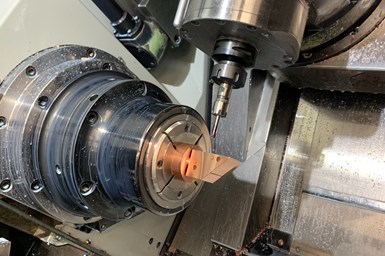
This photo of a part being run on a live-tool CNC lathe was taken during a recent visit to the Chick Machine Company in Butler, Pennsylvania. Note the expansion in the work that can be done efficiently on a CNC turning machine. Perhaps it is an obvious point, but historically only round parts have been run on lathes, not square work like this.
Sometimes, it is the mark of how significant a thing is when we come to regard it as commonplace. That happened with the sort of machining equipment we might call live-tool lathes, multitasking machines or multiprocess machine tools. These are the machine tools capable of various operations historically associated with separate machine types, such as milling and turning in one machine or grinding and milling in one machine. In the case of lathes in particular, I can recall a time when two-axis CNC lathes — machines for turning alone — were common. Now, when a shop I visit points out to me its latest CNC lathe purchase, it is almost always the case that I am looking at a turning machine that has drilling and milling capability, and likely also a subspindle ensuring full access to the entirety of the part.

Shops are separated into those that do lights-out machining and those that do not. The machine types with the largest difference in use between lights-out and not are generally turning-related: turn-mill/multitasking, Swiss-type, twin-spindle turning and twin-turret turning. Graph courtesy of Gardner Intelligence.
Steve Kline, chief data officer with Gardner Intelligence (part of the same company that publishes Modern Machine Shop), tells me my memory probably is not faulty regarding the use of simpler lathes in the past. Gardner Intelligence’s data on machine tool adoption show a clear increase in the embrace of more complex machines even in just the last 10 years. As for why this is — that is, why shops might be more accepting of multiprocess machines and more apt to invest in a multitasking lathe in particular — I see two reasons:
Featured Content
1. These machines have become easier to use. CAM software expects these machines now. Postprocessors run them reliably. That was not always the case.
2. The done-in-one machine tool, most notably a CNC lathe performing all the necessary cutting operations and using a subspindle to reach every face of the part, is the ultimate machining automation platform. Kline says the data reveal this as well. Shops using complex turning machines are the most likely to report they are succeeding with lights-out machining. For these machines, the typical work handling device is a bar feeder, and bar feeder use also strongly correlates to lights-out success. What is the leading automation device for unattended machining — a robot? No, it is the bar feeder.

See the extreme difference between lights-out and non-lights-out facilities when it comes to the use of bar feeders. Lights-out facilities are significantly more likely to use bar feeders than non-lights-out facilities. This graph also makes a distinction between high-ranking shops in MMS’s Top Shops analysis versus other shops. Graph courtesy of Gardner Intelligence.
Pause here. The embrace of lights-out machining is, I would argue, the most important advance happening in machine shops right now. More capacity is needed for the increase in U.S. production that will be the answer to the kinds of supply chain vulnerabilities revealed last year and well into this one. The unattended nighttime hours offer an opportunity to gain this needed capacity. Multiprocess machine tools figure prominently into lights-out production coming into its own, and that makes these machines important.
Articles we have posted recently offer a multifaceted view of these multiprocess machines. Stories touching on this class of equipment describe the role of the operator in using these machines effectively; how serving a new market led naturally to the purchase of this machine type; the experience of adopting CNC Swiss-type machining, a specific type of bar-fed, done-in-one machine; as well as the possibilities for integrating gear machining with cutting and cutting operations with grinding.
All these stories together are not really about technology change, because these types of machine tools have long been with us. Instead, these stories hint at how shops are changing. Automation is now the expectation because “unattended” is the realm of opportunity. Again, my colleagues in data analysis have seen a surge in machine complexity that happened just in the last decade — greater adoption happened fast. This rapid embrace of multiprocess machine tools suggests that what shops now need their machines to do has changed more dramatically than we appreciate.
RELATED CONTENT
-
10 Reasons Why Machine Shops Vary So Much in Quoted Pricing
Many factors explain the potential 10X variation in different shops’ bids for the same machining work.
-
10 Characteristics of a Valuable Machine Shop
What is your machining business worth? A recent event focused on machine shop ownership change revealed what machine shop buyers look for in making this evaluation.
-
3 Mindset Changes for Lights-Out CNC Machining
Expanding capacity into the unattended hours calls for counterintuitive new ways of thinking about the work.



.jpg;width=70;height=70;mode=crop)





.1692800306885.png)




.1687801407690.png)
